The Acropolis of Athens is, without a doubt, one of the great monuments that we all want to be able to visit once in a lifetime.
Declared a World Heritage Site by Unesco , climbing this rocky promontory that concentrates great temples of Antiquity , such as the Parthenon , becomes the main objective of a trip to the Greek capital.

It had been many years since I had the chance to climb the Acropolis during one of my first trips to Europe, so many that I hardly remembered it.

Precisely, from my point of view, the main attraction of this holiday cruise is that during a week you can visit several of the top destinations in Europe, such as Athens , Dubrovnik and Venice .
In the programming of this cruise on the Adriatic, Athens is either the initial stage or the final stage of the cruise, and a question that may arise is whether it is feasible to make a good visit to the city precisely on the days of beginning and end of the cruise. a cruise.
And I can confirm that yes.
Excursions and guided tours in Athens
In our case Athens was the starting point of the cruise, and the schedule of the trip allowed us to make a panoramic visit of the Greek capital and, above all, visit the Acropolis with enough time to get to know this monument well.
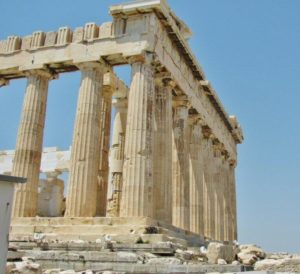
Specifically, our flight from Madrid arrived in Athens at 12 noon.
And from the airport, without worrying about the suitcases, which were directly transferred to the ship, we started our excursion to climb the Acropolis and make a quick tour of other corners of downtown Athens .
In our case it was a private excursion that allowed us to make the most of the time in Athens until the time of boarding and check-in on the cruise, around 6.30 pm.
That is, we had six and a half hours for the visit, which is facilitated because until 11 at night the boat did not start sailing on this first day of cruise.
The stantard group tour offered by Pullmantur lasts four hours and focuses on the visit of the Acropolis .
We had more time with the private tour and we could also walk through the Temple of Zeus .
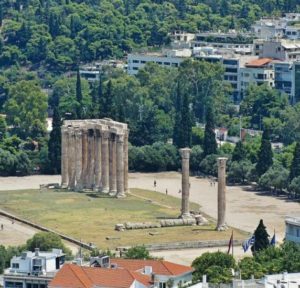
In addition, we took a minibus tour through the center of Athens, through places such as Sintagma Square or Panatinaikos Stadium , and we ate on the terrace of a restaurant in the Plaka neighborhood .
How to climb to visit the Acropolis
But undoubtedly, as I have said, climbing the hill of the Acropolis , which rises 156 meters above sea level, was the great attraction of this excursion.
Since our trip started just at the end of July, we were very afraid of two aspects of the visit; On the one hand, there were too many tourists, and on the other, it was too hot.
The truth is that, yes, there were many tourists, but not many to form long queues at the entrance, something that is quite common at this time and at certain times, and the site of the Acropolis is so large, that there was nowhere accumulation of visitors.
And as for the heat, if it was quite hot, but the gentle breeze that blew on top of the hill facilitated a pleasant visit.
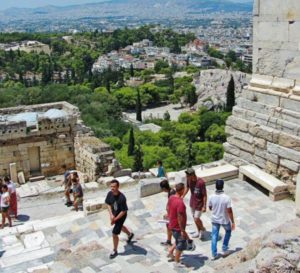
History of the Acropolis of Athens
With the configuration of temples that we can see now, the Acropolis of Athens was built in the middle of the V century BC on the remains of an older acropolis of the Mycenaean civilization .
The Acropolis is the place where the temples dedicated to the gods of the Greek civilization are concentrated, being the Parthenon and the Erectión the main ones of said temples.
During the different civilizations that passed during the following centuries through Athens , the Acropolis was always the religious center of the city.
In this way, for example, the Parthenon housed a Byzantine church, and then with the arrival of the Ottomans, a mosque.

It was in the seventeenth century when during the siege of the city of Athens by the Venetians, the Acropolis suffered severe bombings that caused serious damage.
In particular, in 1687, the Parthenon lost its roof, since, in addition to housing the aforementioned Ottoman mosque, it was a military barracks where there was a powder keg.
What to see during the visit to the Acropolis
To visit the Acropolis , after accessing the entrance to the archaeological site, from a viewpoint you can see the remains of the Herod Amicus Theater built by the Romans in the second century.
You will also be in front of the Propylaea , which is what is called the entrance building to the Acropolis, which faces west, is configured with several rows of columns and different levels of soil.
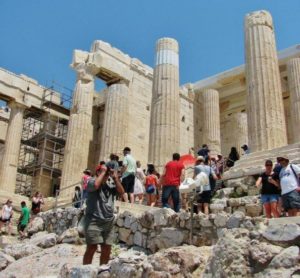
After crossing between the columns you will see the great esplanade of the Acropolis where there are two temples that take center stage.
Parthenon in Athens
In the background on the right you have the Parthenon , a huge Doric style temple, which was built on the foundations of a previous temple.
With two main facades of eight large columns, the entrance facing east, on the side facades are arranged rows of 17 columns.
Do not be surprised to see that a good part of the temple is covered by canvas due to the reforms that have been ongoing for many years.
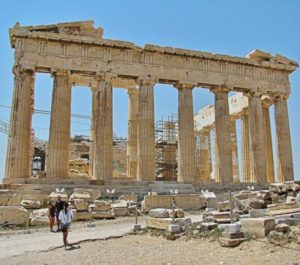
As a curiosity I will tell you that the marbles that were used to raise the temple were brought from a mountain located about 17 kilometers away from its location on the hill.
On the other hand, the columns are structured in several separate sections that are joined by a central iron.
Of course, in the Parthenon you can hardly see any of the mythological figures that covered the facades, which are preserved in the British Museum in London and the new building of the Acropolis Museum in Athens .
Erectión in Athens
The other great temple that you will see is the Erectión , famous for its tribune with the figures of six caryatids , which you find at the bottom on the left as you enter the Acropolis.
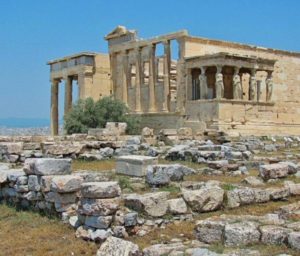
The Erectión began to be built in 421 BC, and is divided into two parts, with a sanctuary dedicated to Athena with Ionic columns, and another area with two chapels.
But it is the Tribune of the Caryatids the architectural and artistic element with which you will be captivated.
That if I mention that the six figures you can see are copies, since five of the originals are in the aforementioned museum of the Acropolis , and the sixth in the British Museum .
Athens Acropolis timetables
The visiting hours of the Acropolis are every day of the week, from 8 in the morning until 8 in the afternoon, with last access half an hour before closing.
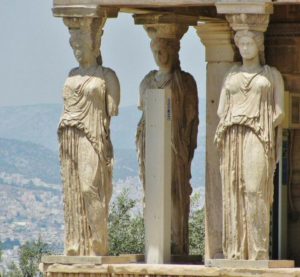
Take into account that if in summer the temperature reaches 39 degrees, the monument is closed to public access between 13 and 17 hours.
The ticket prices to visit the Acropolis are 20 euros the general, and 10 euros the reduced, from which can benefit seniors +65 belonging to countries of the European Union and university students.
Photos of the Acropolis
Here you have more photos of the Acropolis of Athens , with its main temples.
 Countries To Travel Travel Tips and Plans
Countries To Travel Travel Tips and Plans





